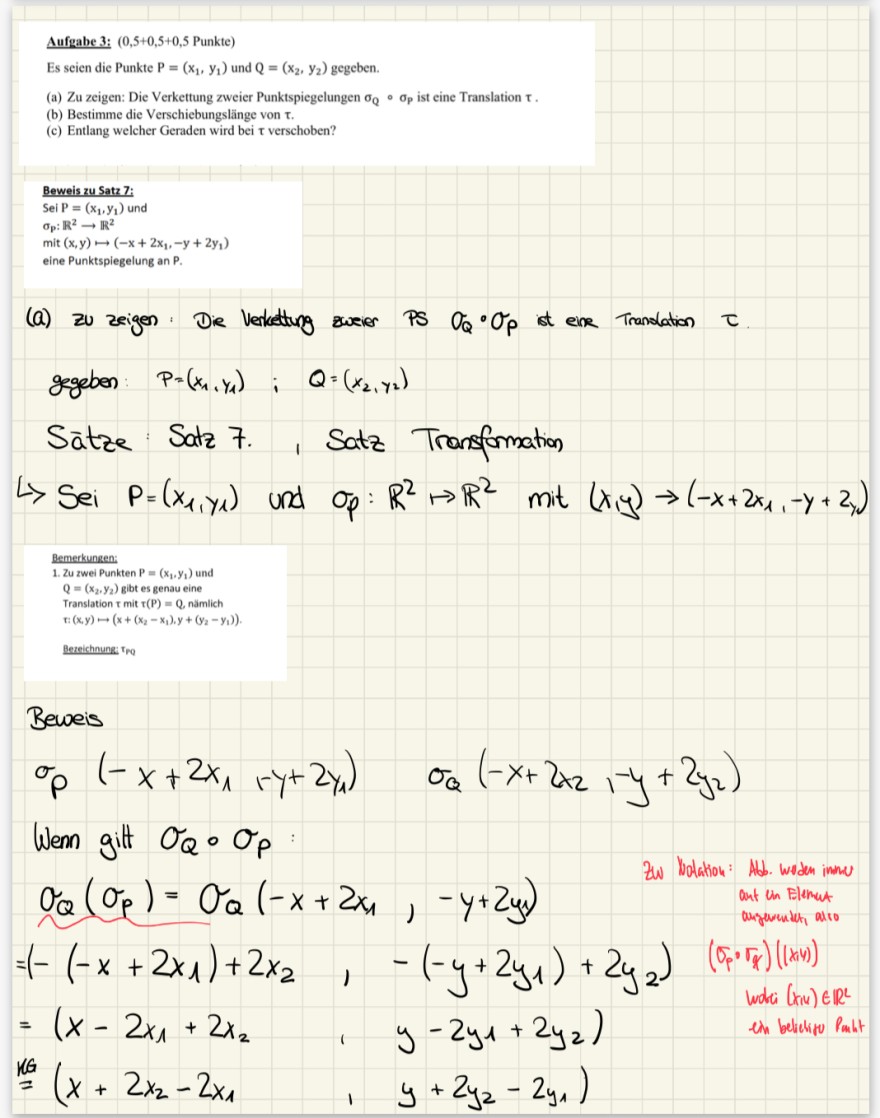wir haben im Studium im Fach Mathematik folgende Aufgabe (siehe Anhang 1) und den darauffolgenden Lösungsansatz (siehe Anhang 2, 3,4) habe ich von einer Kommilitonin erhalten.
Ich wollte fragen, ob mir jemand die Aufgabe erklären kann und ebenfalls, wie bei der Lösung vorgegangen wurde? Leider verstehe ich weder die Aufgabe noch ihren Lösungsweg und selbst hat sie leider keine Zeit, um mir diesen zu erklären.
Das mit rot markierte sind die Korrekturen ihres Übungsleiters.
Ich danke Euch für jede Hilfe!
Liebe Grüße

Text erkannt:
Aufgabe 3: \( (0,5+0,5+0,5 \) Punkte)
Es seien die Punkte \( \mathrm{P}=\left(\mathrm{x}_{1}, \mathrm{y}_{1}\right) \) und \( \mathrm{Q}=\left(\mathrm{x}_{2}, \mathrm{y}_{2}\right) \) gegeben.
(a) Zu zeigen: Die Verkettung zweier Punktspiegelungen \( \sigma_{\mathrm{Q}} \circ \sigma_{\mathrm{P}} \) ist eine Translation \( \tau \).
(b) Bestimme die Verschiebungslänge von \( \tau \).
(c) Entlang welcher Geraden wird bei \( \tau \) verschoben?

Text erkannt:
Aufgabe 3: \( (0,5+0,5+0,5 \) Punkte)
Es seien die Punkte \( \mathrm{P}=\left(\mathrm{x}_{1}, \mathrm{y}_{1}\right) \) und \( \mathrm{Q}=\left(\mathrm{x}_{2}, \mathrm{y}_{2}\right) \) gegeben.
(a) Zu zeigen: Die Verkettung zweier Punktspiegelungen \( \sigma_{\mathrm{Q}} \circ \sigma_{\mathrm{P}} \) ist eine Translation \( \tau \).
(b) Bestimme die Verschiebungslänge von \( \tau \).
(c) Entlang welcher Geraden wird bei \( \tau \) verschoben?

Text erkannt:
Aufgabe 3: \( (0,5+0,5+0,5 \) Punkte)
Es seien die Punkte \( P=\left(x_{1}, y_{1}\right) \) und \( Q=\left(x_{2}, y_{2}\right) \) gegeben.
(a) Zu zeigen: Die Verkettung zweier Punktspiegelungen \( \sigma_{Q} \circ \sigma_{\mathrm{p}} \) ist eine Translation \( \tau \),
(b) Bestimme die Verschiebungslänge von \( \tau \).
(c) Entlang welcher Geraden wird bei \( \tau \) verschoben?
Beweis zu Satz 7:
Sei \( P=\left(x_{1}, y_{1}\right) \) und
\( \sigma_{p}: \mathbb{R}^{2} \rightarrow \mathbb{R}^{2} \)
mit \( (x, y) \mapsto\left(-x+2 x_{1},-y+2 y_{1}\right) \)
eine Punktspiegelung an \( P \).
(a) zu zeigen: Die Verkettung zweier PS \( \sigma_{Q} \sigma_{P} \) ist eine Translation \( \tau \)
gegeben: \( P=\left(x_{1}, y_{1}\right) ; Q=\left(x_{2}, y_{2}\right) \)
Sätze: Satz 7. Satz Transfomation
\( \rightarrow \) Sei \( P=\left(x_{1}, y_{1}\right) \) und \( \sigma_{p}: \mathbb{R}^{2} \rightarrow \mathbb{R}^{2} \) mit \( (x, y) \rightarrow\left(-x+2 x_{1},-y+2 y\right) \)
Bemerkungen:
1. Zu zwei Punkten \( P=\left(x_{1}, y_{1}\right) \) und
\( Q=\left(x_{2}, y_{2}\right) \) gibt es genau eine Translation \( \tau \) mit \( \tau(P)=0 \), näm
\( \mathrm{t}(\mathrm{x}, \mathrm{y}) \mapsto\left(\mathrm{x}+\left(\mathrm{x}_{2}-\mathrm{x}_{1}\right), \mathrm{y}+\left(\mathrm{y}_{2}-\mathrm{y}_{1}\right)\right) \)
Bereichnung \( \mathrm{T}_{\mathrm{PO}} \)
Beweis
\( \sigma_{P}\left(-x+2 x_{1}+y+2 y_{1}\right) \quad \sigma_{Q}\left(-x+2 x_{2},-y+2 y_{2}\right) \)
Wenn gitt \( \sigma_{Q} \circ \sigma_{P} \)
\( \begin{array}{l} \sigma_{Q}\left(\sigma_{p}\right)=\sigma_{Q}\left(-x+2 x_{1},-y+2 y_{1}\right) \\ =\left(-\left(-x+2 x_{1}\right)+2 x_{2},-\left(-y+2 y_{1}\right)+2 y_{2}\right) \\ =\left(x-2 x_{1}+2 x_{2}\right. \\ \left.y-2 y_{1}+2 y_{2}\right) \\ \left(\sigma_{p}, \sigma_{x}\right)((x, y)) \\ \text { woti }\left(\text { Xiv) } \in \mathbb{R}^{2}\right. \\ \stackrel{\mu G}{=}\left(x+2 x_{2}-2 x_{1} \quad, \quad y+2 y_{2}-2 y_{1}\right) \\ \end{array} \)
Zw Wolation: Abb. Woden inmes ant in Elemut argevendet, also
ein belicition Pant

Text erkannt:
\( \begin{array}{l} =\left(2 \cdot \left(x+\left(x_{2}-x_{1}\right), 2 \cdot\left(y+\left(y_{2}-y_{1}\right)\right)\right.\right. \\ =\left(x+\left(x_{2}-x_{1}\right), \quad y+\left(y_{2}-y_{1}\right)\right) \end{array} \)
Antwort: Daraws zeigt sich, dass die leknnupfung zweier PS \( \sigma_{Q} \circ \sigma_{p} \) eine Translation ist. q.e.d.
(b) Verschiebonglange Pranten \( r= \), and pr..."
\( \sqrt{r^{2}+s^{2}}=\sqrt{\left(2 x_{2}-2 x_{1}\right)^{2}+\left(2 y_{2}-2 y_{1}\right)^{2}}=\cdots=2|\overline{p a}| \)
(c) Gerade
injectivität
Seien \( P=\left(x_{1}, y_{1}\right) \) und \( Q=\left(x_{2}, y_{2}\right) \) mit \( \alpha(P)-\alpha(Q) \)
\( \begin{array}{l} \Leftrightarrow \alpha\left(\left(x_{1} y_{1}\right)=\alpha\left(\left(x_{2}, y_{2}\right)\right)\right. \\ \Leftrightarrow\left(-x+2 x_{1},-y+2 y_{1}\right)=\left(-x+2 x_{2},-y+2 y_{2}\right) \\ \Leftrightarrow-x+2 x_{1}=-x+2 x_{2} \quad 1-y+2 y_{1}=-y+2 y_{2} \\ +x \\ +y \\ \Leftrightarrow 2 x_{1}=2 x_{2} \quad \wedge 2 y_{1}=2 y_{2} \\ \Leftrightarrow \quad x_{1}=x_{2} \quad \wedge y_{1}=y_{2} \end{array} \)

Text erkannt:
Surjectivität
Sei \( (0, v) \in \mathbb{R}^{2} \). Es gitt:
\( \begin{aligned} & \alpha((x, y))=(u, v) \\ \Leftrightarrow & \left(-x+2 x_{1},-y+2 y_{1}\right)=(u, v) \\ \Leftrightarrow & -x+2 x_{1}=u \quad 1-y+2 y_{1}=v \\ \Leftrightarrow & -x=u-2 x_{1} \quad 1 \quad-y=v-2 y_{1} \\ \Leftrightarrow & x=-u+2 x_{1} \quad 1 \quad y=-v+2 y_{1} \end{aligned} \)
Suriektivität: \( \alpha((x, y))=(u, v) \)
Es gilt:
\( (x, y) \in[a, b, c] \)
\( \Leftrightarrow 2 \mathrm{~b} \cdot \mathrm{u}+(\mathrm{a}+2 \mathrm{~b}) \cdot \mathrm{v}+(\mathrm{c}-4 \mathrm{~b}-2 \mathrm{a})=0 \) \( \Leftrightarrow(\mathrm{u}, \mathrm{v}) \in[2 \mathrm{~b}, \mathrm{a}+2 \mathrm{~b}, \mathrm{c}-4 \mathrm{~b}-2 \mathrm{a}] \)
Da \( a, b \) nicht beide Null sind, sind auch
\( 2 \mathrm{~b} \) und \( \mathrm{a}+2 \mathrm{~b} \) nicht beide Null.
Es gilt
\( \begin{aligned} & (x, y) \in[a, b, c] \\ \Leftrightarrow & a x+b y+c=0 \\ \Leftrightarrow & a\left(-u+2 x_{1}\right)+b\left(-v+2 y_{1}\right)+c=0 \\ \Leftrightarrow & a \cdot(-u)+2 x_{1} \cdot a+(-v) \cdot b+2 y_{1} \cdot b+c=0 \end{aligned} \)
Somit gult: \( \alpha(g) \) ist eine Gerade \( \alpha(g)=\left[a \cdot(-u)+2 x \cdot a ;(-v) \cdot b+2 y_{1} \cdot b, c\right] \) q.e.d.
\( N / A \)